Middle Kingdom
Mentuhotep II, the second founder of Egypt.
The 1st Intermediate Period came to an end in 2040 when 11th Dynasty king Mentuhotep II from Thebes finally succeeded in overthrowing the Heracleopolitan kings of the 9th/10th Dynasty, thus reuniting Egypt after almost a century of chaos and civil war. Later generations would come to see Mentuhotep as the second founder of Egypt.
He and his successors launched a new building campaign throughout the country to build impressive monuments. Egypt once again became a prospering nation.
There are, however, indications of dynastic problems. The last king of the 11th dynasty, Mentuhotep IV, was omitted from later king lists, which might indicate that he was considered a usurper.
SHOP ALL; Matte Mini Vases; Glossy Mini Vases; Barbara Barry for MK; Small, Medium and Large Vases; Cold Mountain Vases; Memphis Vases; Garden Wares; Bottle Vases. The Middle Kingdom (c. 2000-1650 BCE) was marked by the reunification of Egypt following a period of weak pharaonic power and civil war called the First Intermediate. Mentuhotep II restored stability in 2041 BCE after launching an attack that met with little resistance. (Historical Terms) a period of Egyptian history extending from the late 11th to the 13th dynasty (?2040–?1670 bc) 2. (Historical Terms) a. The former Chinese empire (from the belief that it lay at the centre of the earth) b. The original 18 provinces of China; China proper.
- Following the First Intermediate Period was the Middle Kingdom Period, spanning from the 11th to part of the 13th Dynasties (some historians consider even the 14th Dynasty part of the Middle Kingdom). During this time, the dominant religion of Egypt was the cult of Osiris. Middle Kingdom of Egypt Timeline (c. 2055-1700 B.C.) 2040 BC.
- Middle Kingdom or Middle Country, Mandarin Zhongguo, Chinese name for China. It dates from c.1000 BC, when it designated the Chou empire situated on the North China Plain. The Chou people, unaware of high civilizations in the West, believed their empire occupied.
His vizier, a man named Amenemhat, probably became the first king of the 12th Dynasty. It is not known with certainty how this Amenemhat came to power: maybe he ceased it, maybe he was named Mentuhotep IV’s successor, or maybe he just rose to the occasion. A stone plate found at el-Lisht shows the names of the two kings next to each other, hinting at the possibility of a co-regency. If indeed there was such a co-regency between Mentuhotep IV and Amenemhat I, then Amenemhat was intended as Mentuhotep's successor and the co-regency was meant to make sure that the transition of power would go uncontested. This principle would be continued throughout most of the 12th Dynasty as well.
Amenemhat I moved the administrative centre of the country from Thebes to a new city, Itj-tawi ('the one that takes the Two Lands'), located somewhere in or near the Fayum-oasis, while Memphis became the official capital again. Thebes would however gain in importance, as it became the centre of the cult of Amun, a god of obscure origins to whom the kings of the 12th Dynasty felt some special allegiance.
Amenemhat I and his successors continued the building policy of the kings of the late 11th Dynasty.
This building activity was financed with the spoils coming from military campaigns in Nubia, where Amenemhat and his son Sesostris I regained control of the region South of the first cataract. Along the Eastern frontier and in Nubia fortresses were built to prevent nomad tribes from entering the country uncontrolled.
Sesostris III brought the 12th Dynasty to its political, economical and cultural climax. He too directed campaigns against Nubia, advancing the Southern border to the second cataract or beyond, where he would later be venerated as a god. Although Egypt did not show an interest in that region for a long time after Sesostris III, he waged the first military campaign against Syria-Palestine, most likely to punish some nomad raiders who had tried to enter the country.
He also made some very important changes in the administration of the country, thus eliminating the local governors who had still retained much of their power since the 1st Intermediate Period.
After the long and prosperous reign of Amenemhat III, the power of the dynasty started to decline. There may have been some tension regarding the succession of Amenemhat III, as his immediate successor, Amenemhat IV, may not have been of royal blood. Perhaps taking advantage of the central government’s weakened influence, a local potentate of foreign origin, founded the 14th Dynasty that ruled the eastern Nile Delta.
With the country divided, the Middle Kingdom came to an end.
Click on the thumbnails below to learn more about the dynasties of the Middle Kingdom:
12th Dynasty (1991-1783)

Also found in: Encyclopedia, Wikipedia.
Middle Kingdom
n Want to thank TFD for its existence? Tell a friend about us, add a link to this page, or visit the webmaster's page for free fun content.
Want to thank TFD for its existence? Tell a friend about us, add a link to this page, or visit the webmaster's page for free fun content. Middle Kingdom China
Link to this page:
Middle Kingdom Government
